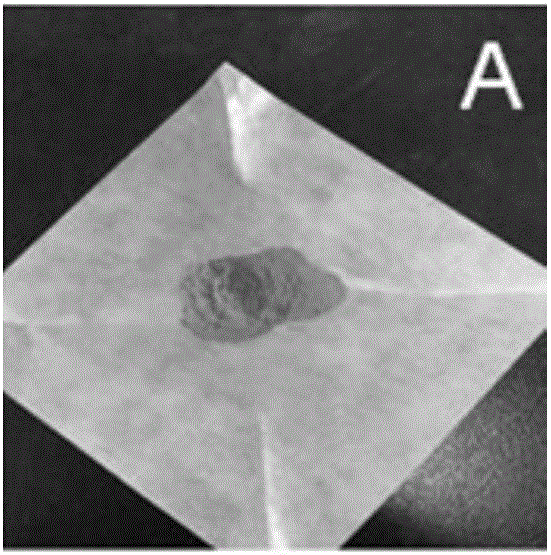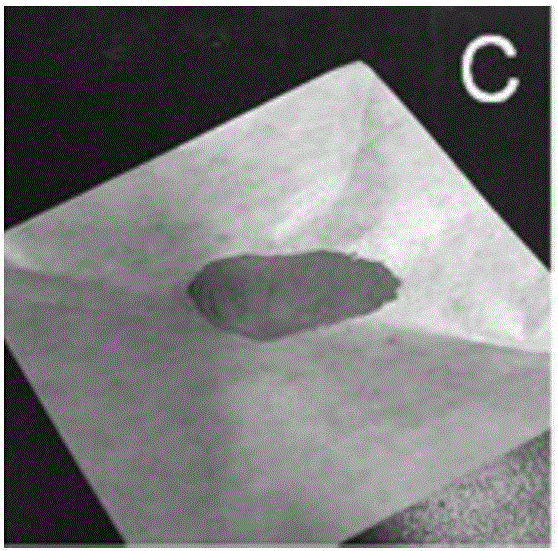Composite adsorbing material of metal organic framework and cuprous salt and preparation method and application thereof
A composite adsorption material and metal-organic framework technology, which is applied in the fields of alkali metal compounds, chemical instruments and methods, adsorption water/sewage treatment, etc., can solve problems that have not been seen yet, achieve good application prospects, be easy to realize, and increase adsorption capacity Effect
- Summary
- Abstract
- Description
- Claims
- Application Information
AI Technical Summary
Problems solved by technology
Method used
Image
Examples
Embodiment 1
[0023] (1) Preparation of HKUST-1 metal-organic framework material
[0024] HKUST-1 was synthesized by hydrothermal method, 1.0 g of 1,3,5-benzenetricarboxylic acid was weighed, dissolved in 30 mL of ethanol / DMF solution with a volume ratio of 1:1, and then 2.077 g copper nitrate trihydrate. React at 100°C for 10h, then absorb the upper layer solution, add DMF to soak for 24h, then change to dichloromethane and soak for 24h, and finally dry it at room temperature, and dry it under vacuum at 120°C for 4h before use.
[0025] (2) Purification treatment cuprous chloride
[0026] Weigh 3-6g of crude cuprous chloride salt, place it in a large open beaker, add a small amount of concentrated hydrochloric acid, just cover the copper salt, add a large amount of deionized water, and then suction filter under the protection of ethanol , and vacuum-dried above 80°C for more than 4 hours. Among them, 3 mL of concentrated hydrochloric acid was added to every 1 g of copper salt until the ...
Embodiment 2
[0033] Purify cuprous chloride, weigh 0.0333g of cuprous chloride after purification, grind it initially at room temperature, then grind it again with 0.3g of HKUST-1, and then bake it at 200°C for 2h in an argon atmosphere , to obtain a composite material composed of cuprous chloride and HKUST-1, wherein the mass fraction of cuprous chloride is 10%. Wherein, the preparation of HKUST-1 and the purification method of cuprous chloride are the same as in Example 1.
[0034] Dissolve 1g of methyl orange in 1000mL of water to prepare an aqueous solution with a methyl orange content of 1000ppm. The mass of the adsorption material in the test tube is 0.05g, add 20mL methyl orange aqueous solution into the test tube, and stir rapidly. After 5min, 15min, 30min, 60min, 120min, 240min, 480min, and 720min, take out the supernatant, measure the content of methyl orange in the taken supernatant with an ultraviolet spectrophotometer, and calculate the adsorption amount. The results are sho...
Embodiment 3
[0037]Purify cuprous chloride, weigh 0.0529g of cuprous chloride after purification, grind it initially at room temperature, then grind it again with 0.3g of HKUST-1, and then roast it at 200°C for 2h in an argon atmosphere , to obtain a composite material composed of cuprous chloride and HKUST-1, wherein the mass fraction of cuprous chloride is 15%. Wherein, the preparation of HKUST-1 and the purification method of cuprous chloride are the same as in Example 1.
[0038] Dissolve 1g of methyl orange in 1000mL of water to prepare an aqueous solution with a methyl orange content of 1000ppm. The mass of the adsorption material in the test tube is 0.05g, add 20mL methyl orange aqueous solution into the test tube, and stir rapidly. After 5min, 15min, 30min, 60min, 120min, 240min, 480min, and 720min, take out the supernatant, measure the content of methyl orange in the taken supernatant with an ultraviolet spectrophotometer, and calculate the adsorption amount. The results are sho...
PUM
 Login to View More
Login to View More Abstract
Description
Claims
Application Information
 Login to View More
Login to View More - R&D Engineer
- R&D Manager
- IP Professional
- Industry Leading Data Capabilities
- Powerful AI technology
- Patent DNA Extraction
Browse by: Latest US Patents, China's latest patents, Technical Efficacy Thesaurus, Application Domain, Technology Topic, Popular Technical Reports.
© 2024 PatSnap. All rights reserved.Legal|Privacy policy|Modern Slavery Act Transparency Statement|Sitemap|About US| Contact US: help@patsnap.com










